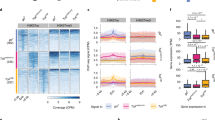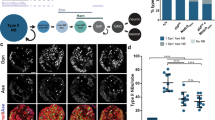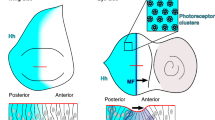Abstract
Gradients of regulatory factors are essential for establishing precise patterns of gene expression during development1,2,3; however, it is not clear how patterning information in multiple gradients is integrated to generate complex body plans. Here we show that opposing gradients of two Drosophila transcriptional repressors, Hunchback (Hb) and Knirps (Kni), position several segments by differentially repressing two distinct regulatory regions (enhancers) of the pair-rule gene even-skipped (eve). Computational and in vivo analyses suggest that enhancer sensitivity to repression is controlled by the number and affinity of repressor-binding sites. Because the kni expression domain is positioned between two gradients of Hb, each enhancer directs expression of a pair of symmetrical stripes, one on each side of the kni domain. Thus, only two enhancers are required for the precise positioning of eight stripe borders (four stripes), or more than half of the whole eve pattern. Our results show that complex developmental expression patterns can be generated by simple repressor gradients. They also support the utility of computational analyses for defining and deciphering regulatory information contained in genomic DNA.
This is a preview of subscription content, access via your institution
Access options
Subscribe to this journal
Receive 51 print issues and online access
$199.00 per year
only $3.90 per issue
Buy this article
- Purchase on Springer Link
- Instant access to full article PDF
Prices may be subject to local taxes which are calculated during checkout




Similar content being viewed by others

References
Driever, W., Thoma, G. & Nusslein-Volhard, C. Determination of spatial domains of zygotic gene expression in the Drosophila embryo by the affinity of binding sites for the bicoid morphogen. Nature 340, 363–367 (1989)
Struhl, G., Johnston, P. & Lawrence, P. A. Control of Drosophila body pattern by the hunchback morphogen gradient. Cell 69, 237–249 (1992)
Jiang, J. & Levine, M. Binding affinities and cooperative interactions with bHLH activators delimit threshold responses to the dorsal gradient morphogen. Cell 72, 741–752 (1993)
Goto, T., Macdonald, P. & Maniatis, T. Early and late periodic patterns of even skipped expression are controlled by distinct regulatory elements that respond to different spatial cues. Cell 57, 413–422 (1989)
Harding, K., Hoey, T., Warrior, R. & Levine, M. Autoregulatory and gap gene response elements of the even-skipped promoter of Drosophila. EMBO J. 8, 1205–1212 (1989)
Fujioka, M., Emi-Sarker, Y., Yusibova, G. L., Goto, T. & Jaynes, J. B. Analysis of an even-skipped rescue transgene reveals both composite and discrete neuronal and early blastoderm enhancers, and multi-stripe positioning by gap gene repressor gradients. Development 126, 2527–2538 (1999)
Small, S., Blair, A. & Levine, M. Regulation of even-skipped stripe 2 in the Drosophila embryo. EMBO J. 11, 4047–4057 (1992)
Small, S., Blair, A. & Levine, M. Regulation of two pair-rule stripes by a single enhancer in the Drosophila embryo. Dev. Biol. 175, 314–324 (1996)
Small, S., Kraut, R., Hoey, T., Warrior, R. & Levine, M. Transcriptional regulation of a pair-rule stripe in Drosophila. Genes Dev. 5, 827–839 (1991)
Stanojevic, D., Small, S. & Levine, M. Regulation of a segmentation stripe by overlapping activators and repressors in the Drosophila embryo. Science 254, 1385–1387 (1991)
Stanojevic, D., Hoey, T. & Levine, M. Sequence-specific DNA-binding activities of the gap proteins encoded by hunchback and Kruppel in Drosophila. Nature 341, 331–335 (1989)
Yan, R., Small, S., Desplan, C., Dearolf, C. R. & Darnell, J. E. Jr Identification of a Stat gene that functions in Drosophila development. Cell 84, 421–430 (1996)
Hou, X. S., Melnick, M. B. & Perrimon, N. Marelle acts downstream of the Drosophila HOP/JAK kinase and encodes a protein similar to the mammalian STATs. Cell 84, 411–419 (1996); erratum ibid. Cell 85, 290 (1996)
Nambu, P. A. & Nambu, J. R. The Drosophila fish-hook gene encodes a HMG domain protein essential for segmentation and CNS development. Development 122, 3467–3475 (1996)
Ip, Y. T., Park, R. E., Kosman, D., Yazdanbakhsh, K. & Levine, M. dorsal–twist interactions establish snail expression in the presumptive mesoderm of the Drosophila embryo. Genes Dev. 6, 1518–1530 (1992)
Papatsenko, D. A. et al. Extraction of functional binding sites from unique regulatory regions: the Drosophila early developmental enhancers. Genome Res. 12, 470–481 (2002)
Lifanov, A. P., Makeev, V. J., Nazina, A. G. & Papatsenko, D. A. Homotypic regulatory clusters in Drosophila. Genome Res. 13, 579–588 (2003)
Berman, B. P. et al. Exploiting transcription factor binding site clustering to identify cis-regulatory modules involved in pattern formation in the Drosophila genome. Proc. Natl Acad. Sci. USA 99, 757–762 (2002)
Kosman, D. & Small, S. Concentration-dependent patterning by an ectopic expression domain of the Drosophila gap gene knirps. Development 124, 1343–1354 (1997)
Hulskamp, M., Pfeifle, C. & Tautz, D. A morphogenetic gradient of hunchback protein organizes the expression of the gap genes Kruppel and knirps in the early Drosophila embryo. Nature 346, 577–580 (1990)
Kraut, R. & Levine, M. Mutually repressive interactions between the gap genes giant and Kruppel define middle body regions of the Drosophila embryo. Development 111, 611–621 (1991)
Struhl, G., Struhl, K. & Macdonald, P. M. The gradient morphogen bicoid is a concentration-dependent transcriptional activator. Cell 57, 1259–1273 (1989)
Driever, W. & Nusslein-Volhard, C. The bicoid protein determines position in the Drosophila embryo in a concentration-dependent manner. Cell 54, 95–104 (1988)
Langeland, J. A., Attai, S. F., Vorwerk, K. & Carroll, S. B. Positioning adjacent pair-rule stripes in the posterior Drosophila embryo. Development 120, 2945–2955 (1994)
Hanna-Rose, W. & Hansen, U. Active repression mechanisms of eukaryotic transcription repressors. Trends Genet. 12, 229–234 (1996)
Gray, S. & Levine, M. Transcriptional repression in development. Curr. Opin. Cell Biol. 8, 358–364 (1996)
Andrioli, L. P., Vasisht, V., Theodosopoulou, E., Oberstein, A. & Small, S. Anterior repression of a Drosophila stripe enhancer requires three position-specific mechanisms. Development 129, 4931–4940 (2002)
Small, S. In vivo analysis of lacZ fusion genes in transgenic Drosophila melanogaster. Methods Enzymol. 326, 146–159 (2000)
Struhl, G., Fitzgerald, K. & Greenwald, I. Intrinsic activity of the Lin-12 and Notch intracellular domains in vivo. Cell 74, 331–345 (1993)
Lawrence, P. A., Johnston, P., Macdonald, P. & Struhl, G. Borders of parasegments in Drosophila embryos are delimited by the fushi tarazu and even-skipped genes. Nature 328, 440–442 (1987)
Acknowledgements
We thank M. Fujioka and J. Jaynes for transgenic flies containing the eve 4 + 6–lacZ construct; L. Andrioli for discussions and support; A. Oberstein for technical assistance; and C. Desplan, J. Blau and T. Cook for encouragement and comments on the manuscript. D.E.C. was supported by a grant from the NSF. This work was also supported by a grant from the NIH.
Author information
Authors and Affiliations
Corresponding author
Ethics declarations
Competing interests
The authors declare that they have no competing financial interests.
Supplementary information
Rights and permissions
About this article
Cite this article
Clyde, D., Corado, M., Wu, X. et al. A self-organizing system of repressor gradients establishes segmental complexity in Drosophila. Nature 426, 849–853 (2003). https://doi.org/10.1038/nature02189
Received:
Accepted:
Issue Date:
DOI: https://doi.org/10.1038/nature02189
This article is cited by
-
Interpretation of morphogen gradients by a synthetic bistable circuit
Nature Communications (2020)
-
Adapting machine-learning algorithms to design gene circuits
BMC Bioinformatics (2019)
-
Quantitatively predictable control of Drosophila transcriptional enhancers in vivo with engineered transcription factors
Nature Genetics (2016)
-
Tc-knirps plays different roles in the specification of antennal and mandibular parasegment boundaries and is regulated by a pair-rule gene in the beetle Tribolium castaneum
BMC Developmental Biology (2013)
-
Accurate measurements of dynamics and reproducibility in small genetic networks
Molecular Systems Biology (2013)
Comments
By submitting a comment you agree to abide by our Terms and Community Guidelines. If you find something abusive or that does not comply with our terms or guidelines please flag it as inappropriate.


